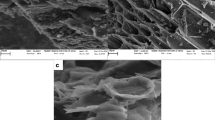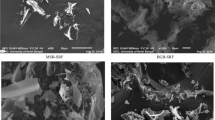Abstract
Biochar is a pyrolyzed product of organic matter having enormous potential for nutrient loading and enhancing nutrient use efficiency. In the present study, two enriched biochar (EB)-based fertilizers were prepared, having a fertilizer grade of 6–6-4 N-P2O5-K2O by intercalation of NPK fertilizers mixture solution as EB-1 and additional humic acid and seaweed extract with EB-1 as a formulation of EB-2. The batch experiments were conducted to compare nutrients (NH4+, NO3−, P, and K+) release patterns of developed fertilizers with conventional fertilizers. Enriched biochar fertilizers (EB) demonstrated a much slower release pattern of NH4+, P, and K+, but NO3− release was similar to conventional fertilizers. The total release of N from EB fertilizers was like conventional fertilizer; however, significantly less P and K were released during the period of 36 h. The field response study in direct-seeded rice revealed that the application of EB fertilizers 11.7–29.5, 32.9–64.0, and 31.4–38.0% higher apparent use efficiency of N, P, and K, respectively than conventional fertilizer at 100% application rate. This implies the possible utilization of EB fertilizers in sustainable rice production with reduced losses and enhanced nutrient use efficiency (NUE).





Similar content being viewed by others
Data availability
All the data generated or analyzed during this study are included in this article.
References
Singh VK, Dwivedi BS, Tewari KN, Majumder K, Rani M, Singh SK, Timsina J (2014) Optimizing nutrient management strategies for rice-wheat system in the Indo-Gangetic Plains of India and adjacent region for higher productivity, nutrient use efficiency and profits. Fields Crops Res 164:405–412
Singh S, Chaturvedi S, Dhyani VC, Govindaraju K (2020) Pyrolysis temperature influences the characteristics of rice straw and husk biochar and sorption/desorption behaviour of their biourea composite. Bioresour Technol 314:123674
Sumit C, Vendra SS, Dhyani VC, Govindaraju K, Vinu R, Mandal S (2021) Characterization, bioenergy value, and thermal stability of biochars derived from diverse agriculture and forestry lignocellulosic wastes. Biomass Conv Bioref. https://doi.org/10.1007/s13399-020-01239-2
Lehmann J, Gaunt J, Rondon M (2006) Bio-char sequestration in terrestrial ecosystems: A review. Mitig Adapt Strat Glob Change 11:403–427
Dong D, Wang C, Zwieten LV, Wang H, Jiang P, Zhou M, Wu W (2019) An effective biochar-based slow-release fertilizer for reducing nitrogen loss in paddy fields. J Soils Sediments 20:3027–3040
Liu X, Liao J, Song H, Yang Y, Guan G, Zhang Z (2019) A biochar-based route for environmentally friendly controlled release of nitrogen: urea-loaded biochar and bentonite composite. Sci Rep 9:9548–9558
Kimetu JM, Lehmann J (2010) Stability and stabilisation of biochar and green manure in soil with different organic carbon contents. Australian J Soil Res 48:577–585
Mizuta K, Matsumoto T, Hatate Y, Nishihara K, Nakanishi T (2004) Removal of nitrate nitrogen from drinking water using bamboo powder charcoal. Bioresour Technol 95:255–257
O’Connor D, Peng TY, Zhang JL, Tsang DCW, Alessi DS, Shen ZT, Bolan NS, Hou DY (2018) Biochar application for the remediation of heavy metal polluted land: a review of in situ field trials. Sci Total Environ 619:815–826
Mukherjee A, Lal R, Zimmerman AR (2014) Impacts of biochar and other amendments on soil-carbon and nitrogen stability: a laboratory column study. Soil Sci Soc American J 78:1258–1266
Fryda L, Visser R (2015) Biochar for soil improvement: evaluation of biochar from gasification and slow pyrolysis. Agriculture 5:1076–1115
Yang D, Liu Y, Liu S, Li Z, Tan X, Huang X, Zeng G, Zhou L, Zheng B (2016) Biochar to improve soil fertility: a review. Agron Sustain Dev 36:36
Joseph S, Graber ER, Chia C, Munroe P, Donne SS, Thomas T, Nielse S, Marjo C, Rutlidge H, Pan GX, Li L, Taylor P, Rawal A, Hook J (2013) Shifting paradigms: development of high-efficiency biochar fertilizers based on nanostructures and soluble components. Carbon Manag 4:323–343
Qian L, Chen L, Joseph S, Pan GX, Li LQ, Zheng JW, Zhang XH, Zheng JF, Yu XY, Wang JF (2014) Biochar compound fertilizer as an option to reach high productivity but low carbon intensity in rice agriculture of China. Carbon Manag 5:145–154
Zheng JF, Han JM, Liu ZW, Xia WB, Zhang XH, Li LQ, Liu XY, Bian RJ, Cheng K, Zheng JW, Pan GX (2017) Biochar compound fertilizer increases nitrogen productivity and economic benefits but decreases carbon emission of maize production. Agricult Ecosys Environ 241:70–78
Yao CX, Joseph S, Li LQ, Pan GX, Lin Y, Munroe P, Pace B, Taherymoosavi S, Van Zwieten L, Thomas T, Nielsen S, Ye J, Donne S (2015) Developing more effective enhanced biochar fertilizers for improvement of pepper yield and quality. Pedosphere 25:703–712
Blackwell GA, Nigro SJ, Hall RM (2015) Evolution of AbGRI2-0, the progenitor of the AbGRI2 resistance island in global clone 2 of Acinetobacter baumannii. Antimicrob Agents Chemother 60:1421–1429
Asai H, Samson BK, Stephan HM, Songyikhangsuthor K, Homma K, Kiyono Y, Inoue Y, Shiraiwa T, Horie T (2009) Biochar amendment techniques for upland rice production in Northern Laos: 1. Soil physical properties, leaf SPAD and grain yield. Field Crops Res 111:81–84
Si L, Xie Y, Ma Q, Wu L (2018) The short-term effects of rice straw biochar, nitrogen and phosphorus fertilizer on rice yield and soil properties in a cold waterlogged paddy field. Sustain 10:537
Zhao L, Cao X, Zheng W, Scott JW, Sharma BK, Chen X (2016) Co-pyrolysis of biomass with phosphate fertilizers to improve biochar carbon retention, slow nutrient release, and stabilize heavy metals in soil. ACS Sustain Chem Eng 4:1630–1636
An X, Wu Z, Yu J, Cravotto G, Liu X, Li Q, Yu B (2020) Copyrolysis of biomass, bentonite, and nutrients as a new strategy for the synthesis of improved biochar-based slow-release fertilizers. ACS Sustain Chem Eng 8:3181–3190
Gao HY, He XS, Chen XX (2012) Effect of biochar and biochar-based ammonium nitrate fertilizers on soil chemical properties and crop yield. J Agro-Environ Sci 31:1948–1955
Ghezzehei TA, Sarkhot DV, Berhe AA (2014) Biochar can be used to capture essential nutrients from dairy wastewater and improve soil physico-chemical properties. Solid Earth 5:953–962
Yao Y, Gao B, Chen J, Yang L (2013) Engineered biochar reclaiming phosphate from aqueous solutions: mechanisms and potential application as a slow-release fertilizer. Environ Sci Technol 47:8700–8708
Bordoloi N, Narzari R, Chutia RS, Bhaskar T, Kataki R (2015) Pyrolysis of Mesua ferrea and Pongamia glabra seed cover: characterization of bio-oil and its sub-fractions. Bioresour Technol 178:83–89
International ASTM D3172–13 (2013) Standard practice for proximate analysis of coal and coke.
International D3176–09 (2013) Standard practice for ultimate analysis of coal and coke.
Mandal S, Bhattacharya TK, Verma AK, Haydary J (2018) Optimization of process parameters for bio-oil synthesis from pine needles (Pinus roxburghii) using response surface methodology. Chem Pap 72:603–616
Al-Wabel MI, Al-Omran A, El-Naggar AH, Nadeem M, Usman ARA (2013) Pyrolysis temperature induced changes in characteristics and chemical composition of biochar produced from conocarpus wastes. Bioresour Technol 131:374–379
Keiluweit M, Nico PS, Johnson MG, Kleber M (2010) Dynamic molecular structure of plant biomass-derived black carbon (Biochar). Environ Sci Technol 44:1247–1253
Lawrinenko M, Laird DA (2015) Anion exchange capacity of biochar. Green Chem 17:4628–4636
Yuan H, Lu T, Wang Y, Huang H, Chen Y (2014) Influence of pyrolysis temperature and holding time on properties of biochar derived from medicinal herb (Radix isatidis) residue and its effect on soil CO2 emission. J Anal Appl Pyrolysis 110:277–284
Shaheen SM, Niazi NK, Hassan NEE, Bibi I, Wang H, Tsang DCW, Ok YS, Bolan N, Rinklebe J (2019) Wood-based biochar for the removal of potentially toxic elements in water and wastewater: a critical review. Int Mater Rev 64:216–247
Wen P, Wu Z, Han G, Cravotto G, Wang J, Ye B (2017) Microwave-assisted synthesis of a novel biochar based slow-release nitrogen fertilizer with enhanced water-retention capacity. ACS Sustain Chem Eng 5(8):7374–7382
Cai Y, Qi H, Liu Y, He X (2016) Sorption/desorption behavior and mechanism of NH4+ by biochar as a nitrogen fertilizer sustained-release material. J Agric Food Chem 64:4958–4964
Gwenzi W, Nyambishi TJ, Chaukura N, Mapope N (2017) Synthesis and nutrient release patterns of a biochar-based N-P-K slow-release fertilizer. Int J Environ Sci Technol 15:405–414
Dias DS, Crespi MS, Torquato LDM, Kobelnik M, Ribeiro CA (2018) Torrefied banana tree fiber pellets having embedded urea for agricultural use. J Therm Anal Calorim 131:705–712
An X, Wu Z, Yu J, Ge L, Li T, Liu X, Yu B (2020) High-efficiency reclaiming phosphate from an aqueous solution by bentonite modified biochars: a slow-release fertilizer with a precise rate regulation. ACS Sustainable Chem Eng 8:6090–6099
An X, Wu Z, Qin H, Liu X, He Y, Xu X, Li T, Yu B (2021) Integrated co-pyrolysis and coating for the synthesis of a new coated biochar-based fertilizer with enhanced slow-release performance. J Cleaner Production 283:124642
Das O, Sarmah AK (2015) The love–hate relationship of pyrolysis biochar and water: a perspective. Sci Total Environ 512–513:682–685
Wang J, Chen C (2006) Biosorption of heavy metals by Saccharomyces cerevisiae: a review. Biotechnol Adv 24:427–451
Berber-Mendoza MS, Leyva-Ramos R, Cerino-Cordoba FJ, Mendoza-Barron J, Garcia HJA, Flores-Cano JV (2013) Role of carboxylic sites in the adsorption of nickel (II) and zinc (II) onto plain and oxidized activated carbon fibers. Water Air Soil Pollut 224:1–12
Utomo WH, Islami T, Wisnubroto E, Soelistyari HT (2017) Biochar as a carrier for nitrogen plant nutrition: effect of enriched biochar on rice (Oryza sativa L.) yield and soil qualities. Int J Appl Eng Res 12:10426–10432
Huang M, Yang L, Qin H, Jiang L, Zou Y (2013) Quantifying the effect of biochar amendment on soil quality and crop productivity in Chinese rice paddies. Field Crops Res 154:172–177
Dong D, Feng Q, McGrouther K, Yang M, Wang H, Wu W (2015) Effects of biochar amendment on rice growth and nitrogen retention in a waterlogged paddy field. J Soils Sediments 15:153–162
Chan KY, Zwieten VL, Meszaros I, Dowine A, Joseph S (2008) Using poultry litter biochars as soil amendments. Australian J Soil Res 46:437–444
Steiner C, Glaser B, Teixeira W, Lehmann J, Blum WEH, Zech W (2008) Nitrogen retention and plant uptake on a highly weathered central Amazonian Ferralsol amended with compost and charcoal. J Plant Nutr Soil Sci 171:893–899
Elmer WH, Pignatello JJ (2011) Effect of biochar amendments on mycorrhizal associations and Fusarium crown and root rot of sparagus in replant soils. Plant Dis 95:960–966
Funding
The author (S.C.) thanks ICAR-NICRA, CRIDA, Hyderabad, Government of India for financial support.
Author information
Authors and Affiliations
Contributions
Arkaprava Roy: data collection, analysis, and writing; Sumit Chaturvedi: designing the experiments, writing, reviewing, and editing; Suhita Pyne and Shiv Vendra Singh: analysis and data collection; Govindaraju Kasivelu and V. C. Dhyani: reviewing and editing.
Corresponding author
Ethics declarations
Ethics approval
Not applicable.
Consent to participate
Not applicable.
Consent for publication
Not applicable.
Competing interest
The authors declare no competing interests.
Additional information
Publisher's note
Springer Nature remains neutral with regard to jurisdictional claims in published maps and institutional affiliations.
Rights and permissions
About this article
Cite this article
Roy, A., Chaturvedi, S., Singh, S.V. et al. Preparation and evaluation of two enriched biochar-based fertilizers for nutrient release kinetics and agronomic effectiveness in direct-seeded rice. Biomass Conv. Bioref. 14, 2007–2018 (2024). https://doi.org/10.1007/s13399-022-02488-z
Received:
Revised:
Accepted:
Published:
Issue Date:
DOI: https://doi.org/10.1007/s13399-022-02488-z




